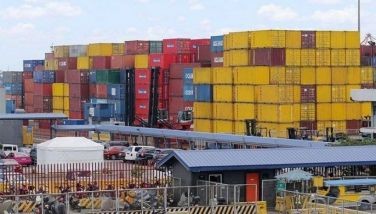International economic engagement

Reports that the implementation of the Philippine-EFTA Free Trade Agreement was being delayed because internal procedures have not yet been completed is embarrassing for the country.
Fortunately, Trade Secretary Ramon Lopez is on top of the situation. This is an agreement with a group of countries — Iceland, Lichtenstein, Norway, and Switzerland — with whom we have only modest trade with and a few products that can be considered sensitive. And yet it took two years to negotiate, and a further two years to get ratified. This is only the second bilateral FTA that we have signed, the first being the Japan-Philippine Economic Partnership Agreement (JPEPA) that took two and a half years to negotiate, and two more years to ratify after rather acrimonious proceedings. The fact that these are the only two bilateral FTA that we have and that it took so long to negotiate and ratify betray a lack of appreciation for and a full-blown commitment to our country’s economic engagement with the rest of the world.
In contrast, our ASEAN neighbors are upping their game of engaging on the economic front with a host of trading partners. As to be expected, Singapore leads the pack with 14 signed FTAs. Although late in the game, Malaysia now has 10 signed FTAs, Thailand has six, Indonesia has five, Vietnam has four and Brunei has two. These numbers do not include those currently under negotiations, nor those under regional arrangements like ASEAN. Nor does it count the participation of four ASEAN members in the CTPP (Trans Pacific Partnership minus the US), which gives them duty free access to seven non-ASEAN member countries.
It goes without saying that the reason we should enter any bilateral or regional FTAs is not because others are doing it and so should we. Ultimately, it should be guided by the national interest and among its myriad dimensions those definitely include job creation and poverty alleviation. Although FTAs are very much about market access and investment liberalization in general, it has positive dynamic consequences to attracting foreign investments, facilitating trade, promoting services capacity, institution-building, upgrading technology and enhancing industry competitiveness. This is particularly crucial in a world where the dominant business model is one of global value chain (GVC) production where the end product, regardless of being industrial or agricultural in nature, goes through processing in various locations incorporating components from all over the world. Examples of such production in the Philippines include hard disk drives (Toshiba, Western Digital), watches (Timex), printers (Epson, Canon) and even Coach bags. Many wonder why Vietnam, a developing economy, joined the TPP (now the CTPP – US). One main reason is that Vietnam is a major participant — more than the Philippines — in GVC production, and its membership in the CTPP will enhance its participation in global production chains even more. FTAs provide that additional incentive for companies to locate their facilities in member countries and not in others. Their products and components and even personnel can move more freely and they don’t have to worry about differing standards or rules of origin. The greater the number of participants in an FTA, particularly big economies, the more compelling it is for a company to locate in those members where cost of labor is cheaper and are close to the supply chain.
In the Philippines, the debate has focused on industries that may be adversely affected and on side issues like environmental concerns or local workers being displaced rather than the merits of the access to the partner’s markets that the agreement or the investments that it will bring. The crux of the debate on JPEPA was the fear that toxic wastes may be dumped on the Philippines because they were on the customary tariff lists existing at that time. As it turns out, the agreement did not do away with the ability of the Philippines to protect the environment from such dumping of wastes under current laws. Such pre-occupation ignored the JPEPA’s pioneering approach to economic partnership on issues such as the freer trans-border flow of people, capital, and information, along with areas like investment, competition, government procurement, trade facilitation, as well as cooperation in science and technology (S&T), human resource development (HRD), small and medium enterprises (SMEs), and the environment. Surely the benefits from these far outweigh the potential risks, which can be controlled.
The problem is that I think both government and industry do not clearly discern that international economic engagements — particularly preferential trading arrangements — as a complementary tool in the country’s development and competitiveness strategies, particularly their impact on production of goods, the provision of services, and investments.
If we are clear about what we want — which is to get the maximum opportunities for exports of goods and services and investments, then we would have a clear direction on what we should negotiate in terms of our commitments and safeguards within this overall development frame work. Once that is done, the next step would be to identify trade partners we can maximize getting what we want via an FTA and not just any willing partner because our negotiating resources are limited in the first place.
I understand that in the DTI, it is the very competent Undersecretary Ceferino Rodolfo that has that portfolio backed by a small staff. I have long advocated a specialized Office of Trade and Investment Negotiations since the coverage of an FTA cuts across the jurisdiction of several agencies of government. An independent office, under the Office of the President, is in a best position to balance competing mandates from these agencies that best serve the national interest. It should be complemented with a mechanism for close and continuing consultation with the industry and with Congress during the negotiation stage to avoid a situation where a signed or nearly signed agreement has to be negotiated again internally because they did not obtain a buy in from these stakeholders during the process.
In going through this process of self-assessment on how to maximize the benefits from international economic engagement, it inevitably ends up with the realization of the current state of our global competitiveness. But instead of concluding that, we cannot compete in certain sectors because of certain structural impediments that raise the costs of production and of doing business. Our policy makers should see this as an opportunity to address them through reforms. What better justification is there to overcome inertia of the status quo and generate the necessary political will for reform than getting a return in terms of more exports and more investments, which translates into more jobs than what could possibly be lost by opening our market.
In this sense, international economic engagement acts like a flashlight that reveals all the flaws that makes an economy inefficient and uncompetitive. Our ASEAN neighbors have come to appreciate this much earlier than we have.
- Latest
- Trending



























